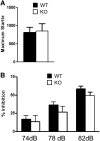Kv4.2 knockout mice have hippocampal-dependent learning and memory deficits
- PMID: 22505720
- PMCID: PMC3348517
- DOI: 10.1101/lm.023614.111
Kv4.2 knockout mice have hippocampal-dependent learning and memory deficits
Abstract
Kv4.2 channels contribute to the transient, outward K(+) current (A-type current) in hippocampal dendrites, and modulation of this current substantially alters dendritic excitability. Using Kv4.2 knockout (KO) mice, we examined the role of Kv4.2 in hippocampal-dependent learning and memory. We found that Kv4.2 KO mice showed a deficit in the learning phase of the Morris water maze (MWM) and significant impairment in the probe trial compared with wild type (WT). Kv4.2 KO mice also demonstrated a specific deficit in contextual learning in the fear-conditioning test, without impairment in the conditioned stimulus or new context condition. Kv4.2 KO mice had normal activity, anxiety levels, and prepulse inhibition compared with WT mice. A compensatory increase in tonic inhibition has been previously described in hippocampal slice recordings from Kv4.2 KO mice. In an attempt to decipher whether increased tonic inhibition contributed to the learning and memory deficits in Kv4.2 KO mice, we administered picrotoxin to block GABA(A) receptors (GABA(A)R), and thereby tonic inhibition. This manipulation had no effect on behavior in the WT or KO mice. Furthermore, total protein levels of the α5 or δ GABA(A)R subunits, which contribute to tonic inhibition, were unchanged in hippocampus. Overall, our findings add to the growing body of evidence, suggesting an important role for Kv4.2 channels in hippocampal-dependent learning and memory.
Figures





Similar articles
-
The role of calsenilin/DREAM/KChIP3 in contextual fear conditioning.Learn Mem. 2009 Feb 17;16(3):167-77. doi: 10.1101/lm.1261709. Print 2009 Mar. Learn Mem. 2009. PMID: 19223600 Free PMC article.
-
Altered synaptic and non-synaptic properties of CA1 pyramidal neurons in Kv4.2 knockout mice.J Physiol. 2008 Aug 15;586(16):3881-92. doi: 10.1113/jphysiol.2008.154336. Epub 2008 Jun 19. J Physiol. 2008. PMID: 18566000 Free PMC article.
-
Kv4 potassium channels modulate hippocampal EPSP-spike potentiation and spatial memory in rats.Learn Mem. 2012 Jun 14;19(7):282-93. doi: 10.1101/lm.025411.111. Learn Mem. 2012. PMID: 22700470
-
Kv4.2 knockout mice display learning and memory deficits in the Lashley maze.F1000Res. 2016 Oct 5;5:2456. doi: 10.12688/f1000research.9664.2. eCollection 2016. F1000Res. 2016. PMID: 28163893 Free PMC article.
-
Pharmacological Approaches for the Modulation of the Potassium Channel KV4.x and KChIPs.Int J Mol Sci. 2021 Jan 31;22(3):1419. doi: 10.3390/ijms22031419. Int J Mol Sci. 2021. PMID: 33572566 Free PMC article. Review.
Cited by
-
Linking aβ42-induced hyperexcitability to neurodegeneration, learning and motor deficits, and a shorter lifespan in an Alzheimer's model.PLoS Genet. 2015 Mar 16;11(3):e1005025. doi: 10.1371/journal.pgen.1005025. eCollection 2015 Mar. PLoS Genet. 2015. PMID: 25774758 Free PMC article.
-
KV Channel-Interacting Proteins in the Neurological and Cardiovascular Systems: An Updated Review.Cells. 2023 Jul 20;12(14):1894. doi: 10.3390/cells12141894. Cells. 2023. PMID: 37508558 Free PMC article. Review.
-
Vertical sleeve gastrectomy activates GPBAR-1/TGR5 to sustain weight loss, improve fatty liver, and remit insulin resistance in mice.Hepatology. 2016 Sep;64(3):760-73. doi: 10.1002/hep.28689. Epub 2016 Jul 25. Hepatology. 2016. PMID: 27312543 Free PMC article.
-
Dl-3-n-butylphthalide alleviates cognitive impairment in amyloid precursor protein/presenilin 1 transgenic mice by regulating the striatal-enriched protein tyrosine phosphatase/ERK/cAMP-response element-binding protein signaling pathway.Exp Ther Med. 2022 May;23(5):319. doi: 10.3892/etm.2022.11248. Epub 2022 Mar 10. Exp Ther Med. 2022. PMID: 35350668 Free PMC article.
-
Neuroplasticity of A-type potassium channel complexes induced by chronic alcohol exposure enhances dendritic calcium transients in hippocampus.Psychopharmacology (Berl). 2015 Jun;232(11):1995-2006. doi: 10.1007/s00213-014-3835-4. Epub 2014 Dec 17. Psychopharmacology (Berl). 2015. PMID: 25510858 Free PMC article.
References
-
- Baldwin TJ, Tsaur M-L, Lopez GA, Jan YN, Jan LY 1991. Characterization of a mammalian cDNA for an inactivating voltage-sensitive K+ channel. Neuron 7: 471–483 - PubMed
-
- Bernard C, Anderson A, Becker A, Poolos NP, Beck H, Johnston D 2004. Acquired dendritic channelopathy in temporal lobe epilepsy. Science 305: 532–535 - PubMed
Publication types
MeSH terms
Substances
Grants and funding
LinkOut - more resources
Full Text Sources
Medical
Research Materials
